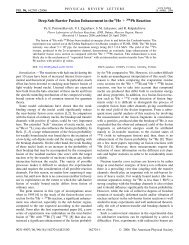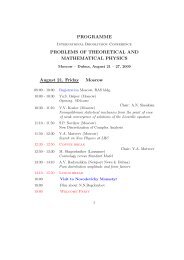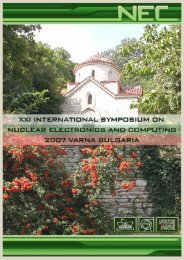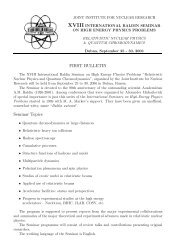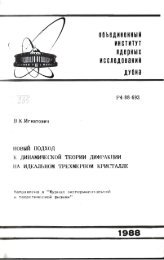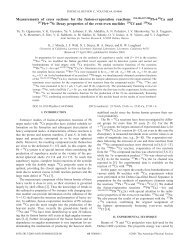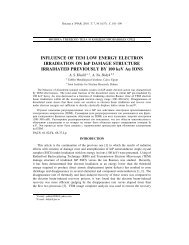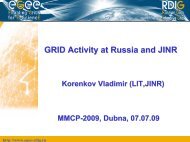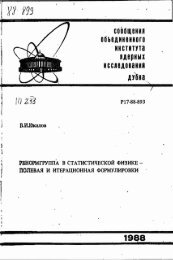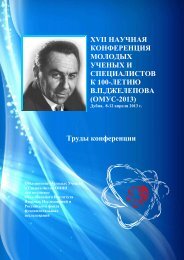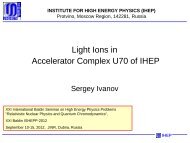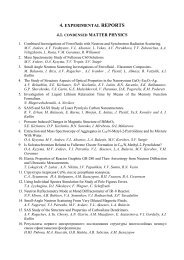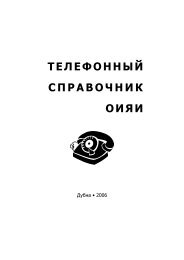Joint Institute for Nuclear Research Relativistic ... - Index of - JINR
Joint Institute for Nuclear Research Relativistic ... - Index of - JINR
Joint Institute for Nuclear Research Relativistic ... - Index of - JINR
You also want an ePaper? Increase the reach of your titles
YUMPU automatically turns print PDFs into web optimized ePapers that Google loves.
NET CHARGE FLUCTUATIONS IN AA COLLISIONS IN A SIMPLE<br />
STRING-INSPIRED MODEL<br />
A.V. Titov 1† , V.V. Vechernin 1<br />
(1) Saint Petersburg State University<br />
† E-mail: arsenii.titov@gmail.com<br />
Net charge fluctuations have been proposed as a possible indicator <strong>of</strong> the <strong>for</strong>mation<br />
<strong>of</strong> quark-gluon plasma in high-energy nucleus-nucleus collisions [1, 2]. The theoretical<br />
predictions <strong>of</strong> the value <strong>of</strong> the fluctuations [1, 2, 3] do not directly consist with the experimental<br />
results from RHIC [4]. At present the results extracted from ALICE experimental<br />
data have also rather ambiguous interpretation in the framework <strong>of</strong> existing models [5].<br />
In this connection, we try to describe the experimental data in the framework <strong>of</strong> an<br />
alternative string-inspired model.<br />
We introduce two effective sources <strong>of</strong> thehadron production. The first source emulates<br />
the mid-rapidity particle production from the decays <strong>of</strong> the strings. In the string model<br />
one has an approximate conservation <strong>of</strong> the charge locally in rapidity, so we assume this<br />
source emits N 1+ positive and N 1− negative particles in the central rapidity interval ∆y<br />
with the same mean values and variances, but due to “leakage” <strong>of</strong> the charge on the<br />
borders <strong>of</strong> the interval N 1+ ≠ N 1− event-by-event. In string models the positive charge<br />
<strong>of</strong> initial nuclear protons is associated with their valence quarks and is concentrated at<br />
projectile and target rapidities. The transport <strong>of</strong> this charge into the mid-rapidity region<br />
∆y is the second cause <strong>of</strong> the deviation <strong>of</strong> the charge from zero in this region. To simulate<br />
this process we introduce the second source which produces only positive particles.<br />
As a result the measure <strong>of</strong> the dynamical net charge fluctuations, ν dyn , is expressed in<br />
terms <strong>of</strong> the model parameters. The parameters <strong>of</strong> the first (main) source are expressed<br />
through the parameters characterizing the individual string and their event-by-event distribution.<br />
The important feature <strong>of</strong> the model is that based on the results obtained in [6]<br />
we do not assume that the engaged fluctuations are poissonian.<br />
The model calculations are compared with the experimental data on pseudorapidity<br />
dependence <strong>of</strong> ν dyn from RHIC [4]. It is shown that under some assumptions the obtained<br />
results are consistent with the data.<br />
References<br />
[1] S. Jeon and V. Koch, Phys. Rev. Lett. 85, 2076 (2000).<br />
[2] M. Asakawa, U. Heinz and B. Muller, Phys. Rev. Lett. 85, 2072 (2000).<br />
[3] E.V. Shuryak and M.A. Stephanov, Phys. Rev. C 63, 064903 (2001).<br />
[4] B.I. Abelev et al. (STAR Collaboration), Phys. Rev. C 79, 024906 (2009).<br />
[5] S. Jena <strong>for</strong> the ALICE Collaboration, arXiv:1203.0542 [nucl-ex] (2012).<br />
[6] V.V. Vechernin and H.S. Nguyen, Phys. Rev. C 84, 054909 (2011).<br />
125



